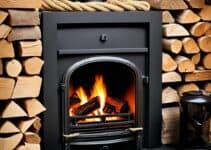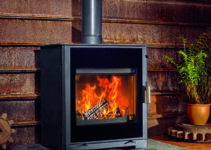Maintaining a log burner comes with the crucial, though often overlooked, responsibility of keeping its flue clean. My professional experience compels me to stress the importance of frequent and proper care to ensure the stove’s safe and efficient functioning.
Factors such as how the stove is used, the type of wood burnt, and even the specific design of the wood-burning unit itself, play a role in determining the frequency of cleaning. Creosote build-up is the primary concern; this tar-like substance can ignite, causing a significant fire hazard. I’ve seen the damage that the extreme temperatures of a chimney fire, soaring up to 2,000 degrees Fahrenheit, can cause—warping metal and fracturing tiles.
I urge my readers to eschew water in extinguishing an active chimney fire as it may inflict further structural damage. Instead, establishing a routine cleaning schedule, be it bi-weekly or at the very least annually, is crucial for mitigating creosote accumulation. Should you ever encounter a chimney fire, immediate steps include dousing the flames within the stove or fireplace, employing a multipurpose dry-chemical extinguisher, and promptly alerting your local fire brigade.
For reliable advice and practical guidelines on how to clean a log burner flue, stay tuned to our comprehensive log burner flue cleaning guide. I’m here to arm you with essential Cleaning Log Burner Flue Tips for a safe, cosy home.
The Importance of Regular Wood Stove Flue Maintenance
Regular upkeep of your wood stove’s flue is akin to preserving the heartbeat of your household’s warmth. With the imminent cold spells, ensuring that your log burner flue maintenance is not just a thought but a practised routine is crucial.
Understanding Creosote Accumulation and Chimney Fires
Creosote, a sticky and flammable byproduct of wood combustion, tends to accumulate in the chimney lining where the temperature fluctuates, causing potential fire hazards. This accumulation is even more prevalent in the upper sections of the chimney, where cooler temperatures facilitate the condensation of smoke and gases, leading to creosote build-up. Cleaning a log burner flue is vital to handle this build-up and prevent the serious risk of chimney fires that can devastate a home.
The Consequences of Neglecting Flue Cleaning
Sidelining log burner flue cleaning methods not only jeopardises your safety but can also herald a multitude of problems. The presence of creosote invites an unpleasant odour that can permeate your home and disrupts the serenity of a warm fireplace. Troubles in lighting fires, an increased risk of carbon monoxide poisoning, and the daunting possibility of internal chimney fires are the consequences that underscore the necessity of regular flue maintenance.
By incorporating methodical log burner flue cleaning methods, we aim not just for functionality but sustainability of the warmth that enlivens our homes. It is my commitment to toe the line of diligence to ensure the safety of my home, and I urge you to adopt the same vigilance with your flue maintenance.
Cleaning Log Burner Flue Tips: Establishing a Cleaning Schedule
As someone who values the warmth and comfort provided by a log burner, understanding the intricacies of flue maintenance is essential for ensuring both safety and efficiency. Establishing a regular cleaning schedule for your log burner flue is a necessary aspect of responsible wood burner ownership. It not only prolongs the life of your heating appliance but also significantly reduces the risk of chimney fires.
Factors Determining the Frequency of Cleaning
The recommended timing of log burner flue maintenance depends on a variety of factors. As a general rule, inspecting and cleaning your log burner flue at least once annually is prudent, especially before the main period of usage in the colder months. Use the following points as a guide to determine a more precise schedule for your log burner:
- Type of Wood: Hardwoods tend to create less creosote than softwoods and thus may require less frequent cleaning.
- Wood Quality: Utilising well-seasoned wood that has been dried for a minimum of six months will minimise creosote accumulation.
- Usage Patterns: High-frequency usage or burning larger amounts of wood will necessitate more regular flue cleanings.
- Stove Efficiency: Modern, efficient wood burners may not need cleaning as often as older, less efficient models.
Identifying the Signs of Creosote Build-Up
Recognising the early signs of creosote accumulation is essential for scheduling flue cleaning. Stay vigilant for the following indicators:
- Odour: An unusual or pungent smell is a valid sign that cleaning is overdue.
- Smoke Issues: Difficulty in lighting fires or smoke entering the room instead of rising up the chimney can suggest a blockage.
- Visual Inspection: Any visible tar-like substance or blackened areas within the flue are clear signs of creosote build-up.
- Performance Decline: A noticeable decrease in stove efficiency could also signal a creosote-clogged flue.
My commitment to providing sound log burner flue maintenance tips extends to emphasising the importance of regular inspections, which allow for timely interventions to keep your home safe and your log burner operating optimally. Remember, a little diligence goes a long way in preventing costly and dangerous emergencies.
| Cleaning Frequency | Indicator | Recommended Action |
|---|---|---|
| Regular Use | Visible soot and creosote | Schedule an annual cleaning |
| Heavy Use | Excess smoke or odour | Consider bi-annual cleaning |
| Moderate Use | Difficulty starting fires | Inspect flue bi-annually; clean as needed |
Retaining these log burner flue cleaning tips in your maintenance repertoire will guarantee your cosy nights by the fire remain both pleasant and secure. Do not underestimate the importance of acknowledging the signs of a flue in need of a clean. After all, a well-maintained log burner flue is integral to both the warmth of your home and the safety of your loved ones.
DIY Vs. Professional Flue Cleaning Methods
Deciding whether to undertake log burner flue cleaning yourself or to call in a professional can be influenced by understanding the differences and benefits of each approach. Let’s delve into how to clean a log burner flue using DIY hacks, and how to discern when the expertise of a professional chimney sweep is necessary.
The Necessities for a Safe DIY Cleaning Process
When I consider cleaning my own log burner flue, I first assess my physical capability and ensure that I have the essential equipment for a thorough and safe cleaning process. One of the greater challenges I face is dealing with the stubborn creosote build-up, which often requires rigorous scrubbing with the right tools. Here’s a list of indispensable items for a DIY flue cleaning:
- Wire chimney brush or an alternative cleaning tool, like a burlap bag filled with straw
- Powerful flashlight to inspect for obstructions
- Industrial shop vacuum for dust and soot removal
- Protective gear, including gloves, a dust mask, and safety goggles
Having acquainted myself with various log burner flue cleaning hacks, I’ve come to realize the importance of regular checks for inspections and cleaning to maintain a safe and efficient stove.
When to Call a Professional Chimney Sweep
Despite my best DIY efforts, there are instances where calling a professional is not only wise but necessary. For example, encountering significant creosote build-up that seems too daunting to handle alone is certainly one such occasion. In this case, the depth of cleaning required surpasses my DIY capabilities, requiring the experienced hand of a professional. They possess specialised tools and methods that can address heavy creosote safely and effectively. Additionally, they offer invaluable insights that can benefit me in maintaining my log burner flue in the future.
| DIY Cleaning | Professional Cleaning |
|---|---|
| Cost-effective in the short term | Higher upfront costs but offers comprehensive service |
| May be time-consuming and physically demanding | Saves personal time and effort |
| Ideal for light to moderate creosote build-up | Recommended for heavy or complicated build-up |
| Requires personal safety precautions | Handled by certified professionals with industry-grade equipment |
Deciding between a DIY or professional approach to log burner flue cleaning doesn’t necessarily come down to one being better than the other; it’s more about what’s most appropriate for my particular situation. Safety, efficiency, and the condition of my log burner flue inform my decision-making process.
Enhancing Wood Stove Safety Through Proper Usage
As an avid user of a wood-burning stove, I’ve come to appreciate the subtleties that contribute to both performance and safety. Key amongst these is the methodical approach to log burner flue maintenance, essential for preventing the hazardous build-up of creosote. Sharing personal experiences and researched knowledge, I aim to arm readers with practical log burner flue cleaning methods and tips for sustained safety.
Choosing the Right Fuel for Minimised Creosote
It’s well-understood that the type of fuel used impacts the volume of creosote amassing within a stove’s chimney. Through persistent use and observation, I’ve honed in on the use of well-seasoned, dry wood as the optimal fuel choice. Damp or unseasoned timber, which I’ve learned to avoid, invariably leads to inefficient combustion and increased creosote deposition. In practice, dry wood not only engenders a cleaner burn but also contributes to a more thorough heat output, reducing the tendency for creosote to condense within the flue.
System Management Techniques to Reduce Build-up
Regarding system management, daily habits play a pivotal role. I can attest to the effectiveness of establishing a routine that involves intense burning sessions. These serve as a proactive measure in diminishing existing creosote layers. Modern, high-efficiency wood stoves, which I highly recommend, are engineered to optimise the burn quality and sustain lower flue temperatures, further diminishing creosote risks. Nevertheless, adherence to annual inspections remains a fundamental best practice, backed by guidance from environmental authorities.
In conclusion, vigilant observance of these practices contributes significantly to the safety and efficacy of wood stove operation. It’s a matter of prioritising meticulous fuel selection and disciplined system management — both of which I’ve woven into my regular maintenance schedule.
Conclusion
As we wrap up our comprehensive guide on maintaining the safety and efficiency of your wood stove flue, I cannot overstress the significance of regular upkeep. From my experience, employing best practices and adhering to a consistent cleaning regimen not only maximises the longevity of your appliance but also safeguards your home against potentially catastrophic events. While we all appreciate the warmth and ambience that our log burners provide, it’s vital to remember that preventive measures are the cornerstone of responsible ownership.
Best Practices for Wood Stove Flue Upkeep
My recommendation is to conduct regular inspections for creosote build-up and to keep a close eye on the structural integrity of your chimney. Deviating from this routine can lead to hazardous conditions that might escape notice until it’s too late. Religiously following a cleaning schedule, tailored to your stove’s usage patterns, ensures that you mitigate risks efficiently. Moreover, should you spot any traces of creosote accumulation, immediate action is required—a step that can avert danger and maintain optimal operation.
The Significance of Yearly Inspections Regardless of Use
Another aspect that demands attention, whether your wood stove is frequently used or not, is the annual inspection. This aspect is often overlooked, but chimneys venting all types of appliances, whether it be wood, gas, or oil systems, require this yearly health check. Normally, a Level 1 visual inspection is ample to give you peace of mind. However, any changes in fuel type or property transactions demand a more in-depth Level 2 assessment. Furthermore, thoughtful disposal of creosote and soot not only exemplifies environmental responsibility but also showcases the resourcefulness of a diligent homeowner. Overall, a meticulous approach to chimney care, rooted in the wisdom of how to clean a log burner flue, is what sets a commendable standard for home maintenance.



